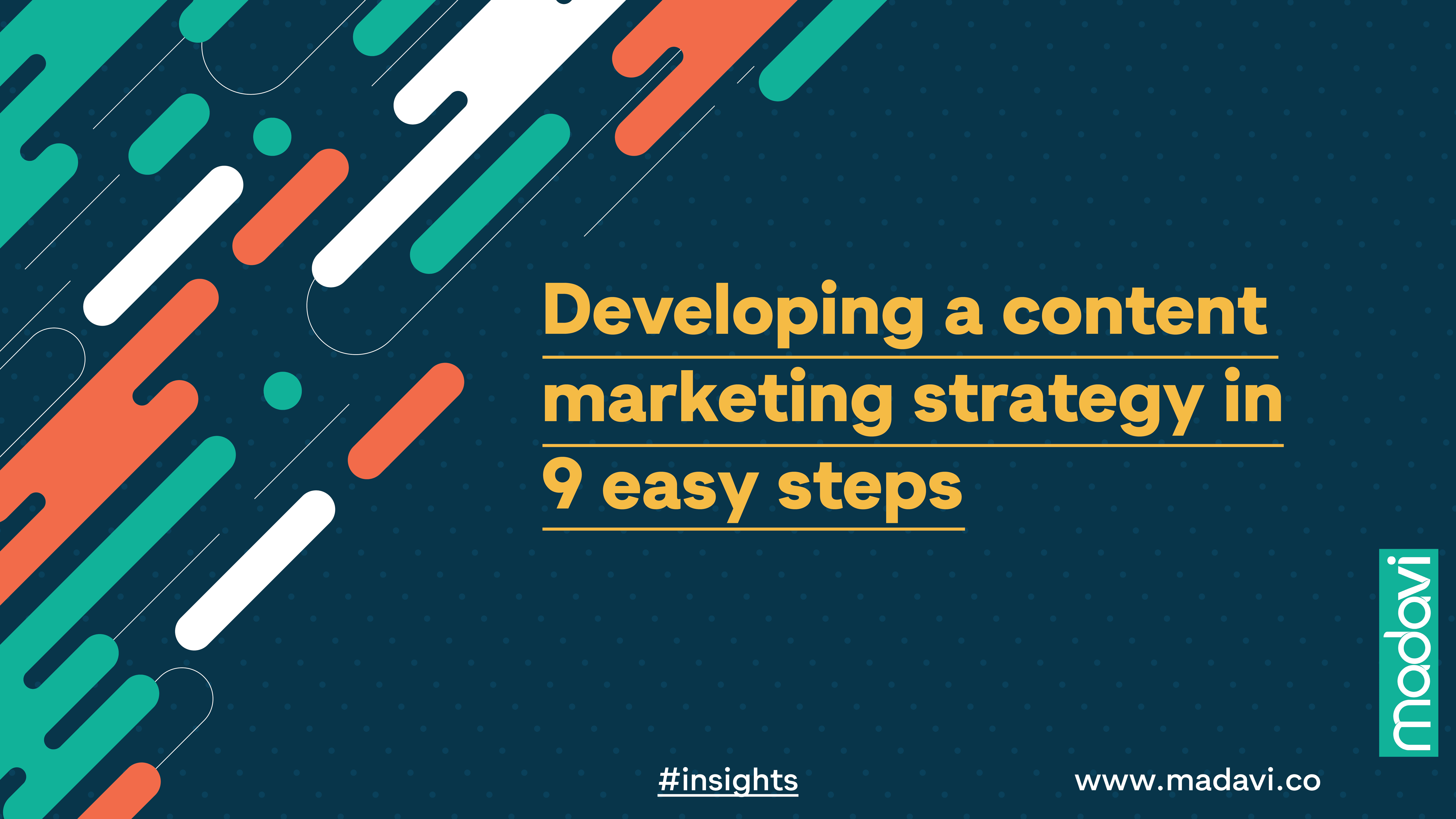Table of Contents
Developing a Content Marketing Strategy in 9 Easy Steps

It is impossible to emphasize enough the importance of content marketing in the contemporary business setting.
Before diving into a highlight of the benefits of this digital marketing strategy, it is essential first to understand what it entails.
Content marketing uses storytelling and information sharing to help businesses reach and connect with potential customers.
As a digital marketing strategy, content marketing primarily intends to achieve the business goals of driving more traffic to a brand’s website and generating leads.
Click here to learn more about digital marketing vs. content marketing
In an age where prospective customers have developed the habit of seeking information before making a purchase, businesses have the opportunity to point them in their direction by providing the information these customers need.
This mainly happens through content marketing.
Businesses that rely on this strategy indirectly engage the customer, build trust, and foster loyalty, all of which increase the likelihood of conversions.
Keeping customers informed, generating leads, and building trust and loyalty are only some of the benefits of a content marketing strategy.
Businesses can also improve their organic ranking through content marketing since the strategy improves Search Engine Optimization (SEO) and is cost-effective, not forgetting that all these benefits are long-term.
Want more? A detailed list and explanation of the benefits of content marketing strategy is found here.
For such a critical component of a brand’s success, it is fundamental to get it right.
A 2023 Semrush report shows that almost 70% of businesses that use content marketing strategies allocate between $3,000-$20,000 of their monthly budget.
This points to the significance accorded content marketing, as well as the need for its effective implementation.
Quality and consistency are some of the basic components of content marketing that are identified as critical to the success of the strategy.
However, there is an even more important component or idea that your business must incorporate to maximize the return on investment of content marketing.
This is the idea of developing a content marketing strategy at the onset of the content marketing efforts to ensure that the efforts pay by achieving desired goals.
Why Do You Need to Develop a Content Marketing Strategy?
Content marketing strategy is sometimes referred to as a content plan or content strategy. These terms can be used interchangeably, as seen in this post.
By definition, a content marketing strategy is a roadmap for the original content your business plans to create as part of its digital marketing strategy.
It focuses on launching a competitive content marketing plan that can either include visual or written materials to promote your brand.

Developing a content marketing strategy mainly aims to answer the question “Why” regarding your adoption of the digital marketing technique.
Without a content marketing plan, your efforts are likely to lead to failure because you will be unable to align the goals of your brand with the goals of the marketing efforts, leading to a waste of resources.
Another important factor to consider is that the content marketing plan must be executed in a particular order. For example, you cannot conduct a topic and keyword research before defining your audience or establishing your goals.
In such a case, your content marketing strategy will be a waste of time since you will not know what keywords are the best for drawing audiences to your content and, by extension, traffic to your website.
According to the Content Marketing Institute, it is not enough to have a content marketing strategy. You have to ensure you document it.
Documenting your business’s content marketing strategy enhances effectiveness because it provides guidelines and acts as a point of reference, allowing smooth information flow. You must want that for your business hence the need to pay attention to how you can achieve it.
9 Steps You Can Use to Develop a Content Marketing Strategy
Below is a step-by-step process for developing a content marketing strategy for best results.
Step 1: Define your Goals
A content marketing strategy without well-defined and clear goals is bound to fail. Defining goals is the main element of the content marketing strategy that answers the question “why”.
Some of the common goals businesses identify when creating a content marketing strategy are to educate users, boost brand awareness, increase consumer engagement, and expand the business’s bottom line.
Regardless of the goals identified, they must be SMART (specific, measurable, achievable, relevant, and time-bound).
A specific goal is not only well-defined but also answers the who, what, where, why, and other related questions. As a result, you have to spend a lot of time determining issues such as who would oversee the content marketing strategy and what your company wants to accomplish.
A measurable goal, on the other hand, concerns how much of an increase and in what areas you want to see. This should be set whether the content marketing plan is being implemented by an agency or in-house.
The goal should also be achievable. This is critical because it will determine the efforts the team puts in because an extremely challenging goal can have a negative impact on their morale and become counterproductive in meeting company objectives.
Hence, you should consider other responsibilities of your team, time constraints, and your company’s marketing budget. These aspects critically influence the achievability of the content marketing strategy goals.
Relevance simply refers to how the goals relate to your business, and lastly, there should be a deadline for your content marketing goals.
These are checkpoints that help you determine how far you are from achieving the goals of your content marketing strategy. You can make necessary adjustments to improve the chances of success.
Defining your goals is the foundation of your content marketing strategy.
Making them SMART is a sure way of enhancing the effectiveness of the content strategy because the goals will help your team know why they are creating content, what they ought to achieve, and when to achieve it.
Step 2: Identify your Audience
Audience demographics, referred to as audience personas in some instances, play a key role when developing a content marketing strategy.
Elements such as location, income, gender, age, and education, among others, are important to integrate into your content marketing strategy. This is because you are looking to convert the readers of your content into customers.
The best way to identify your audience is to conduct thorough market research, which will help you define the various elements, as well as show you what they do on the internet so that you can integrate it into your content.
Aspects such as their go-to social media platforms, where they hang out on the internet, their preferences, who they trust, and their pain points are vital for developing a better understanding of your audience.
Identifying, researching, and understanding your audience helps you tell your brand’s story in a way that captivates their attention and keeps them coming back because you know who is listening, their expectations, and how to meet those expectations.
Therefore, identifying and understanding your audience is a step you should not skip if you want to ensure the effectiveness of your content marketing strategy.
Step 3: Review Existing Content
Once you have defined your goals and identified your audience, the next step is to review your existing content.
Many businesses may shy away from this step, especially if they have never tried content marketing under the impression that there is no content to review.
However, there is always content to review when your business has a website and relies on digital marketing.
Reviewing existing content will provide you with insights regarding the type of content that is generating a lot of interest from your target audience against that which is ineffective.
This step also includes reviewing performance metrics for more objectivity in reviewing existing content.
Integrating these elements helps you build a picture of the desired content that will resonate with your target audience and ensure a return on investment.
Step 4: Research your competitors
Knowing your competitors is important when developing your content marketing strategy. In the contemporary business environment, researching your competitors can act as a benchmark and provide just the information you need to get started.
It is also crucial to investigate who you are competing against to win the attention of your target audience. In this case, the competition is not only from those in the same line of business.
Rather, you are also competing with content from a myriad of other sources, including entertainment platforms and news. Doing this research prepares you for what lies ahead, thereby helping you hone your content for success.
Step 5: Complete Topic and Keyword Research
After identifying your audience, reviewing existing content, and learning about your competitors, it is time to conduct topical and keyword research to curate your content in a way that corresponds with what audiences are searching for online.
For you to attract the attention of audiences and build trust using your content marketing strategy, you have to make sure your content is useful to them and provides them with more value than they expect.
Keyword research helps with this process because it shows what information people are looking for online that is related to your business.
From there, you can get new ideas to include in your content for better ranking and more traffic to your website.
Step 6: Plan Your Resources
Generally, content marketing is the most cost-effective form of digital marketing.
However, there are aspects of the strategy that will require an investment, such as the decision to work with a marketing agency to generate the content, hire an expert to work in-house, or consult.
The resources you put into content marketing depend on the goals you defined and the strategies you develop to help achieve those goals.
A 2023 Semrush report on the monthly average budget for content marketing showed that some companies spend over $20,000 on this digital marketing strategy.
The assumption is that such companies want to do it correctly to maximize the benefits they reap from content marketing.
Therefore, you should not miss the step of planning your resources when creating your content marketing strategy.
Regardless of the resources allocated to your content marketing strategy, the return on investment when you execute it effectively is highly rewarding.
Step 7: Plan a Content Production Schedule
The only way to achieve the SMART goals you developed in the first step of creating your content marketing plan requires being specific about the content marketing tasks to be performed and setting deadlines.
This stage includes bringing all your ideas together and creating a calendar with publication dates to ensure you publish content regularly. Consistency is one of the foundations of quality content.
Hence, you want to ensure you are clear about the personnel assigned a content marketing task, as well as the publication date, for smooth management of the process.
Step 8: Create and Publish Your Content
After so many steps, you finally get to the part where you create the content you want to share with your audience.
Based on the standards you developed after audience and keyword research, you want to make sure that you select the best platforms to publish your content.
For example, you may determine that your target audience prefers the LinkedIn social media platform. As a result, putting more effort into producing content that is aligned with the guidelines of the platform is the best way to get it before your audience.
Make sure the content is valuable and shareable, which will prompt the customers to promote it and generate more leads.
Step 9: Monitor and Evaluate the Performance of Your Content
The same metrics you used to review your existing content can be used to monitor and evaluate the performance of the content you have published. This will help you determine what is working against what is not and the needed refining.
Some of the key performance indicators to measure are website traffic, engagement rates, and conversions.
The metrics will help you improve different dynamics of your content marketing, such as the distribution channels or type of content.
In conclusion, developing a content marketing strategy helps you pay attention to the most minute details of your content.
This explains why it is the most preferred digital marketing strategy because by paying attention to the details, you polish the content and increase your chances of meeting set objectives.
Due to the amount of work involved, many brands prefer to work with a digital marketing agency. The return on investment of such efforts is impressive.







